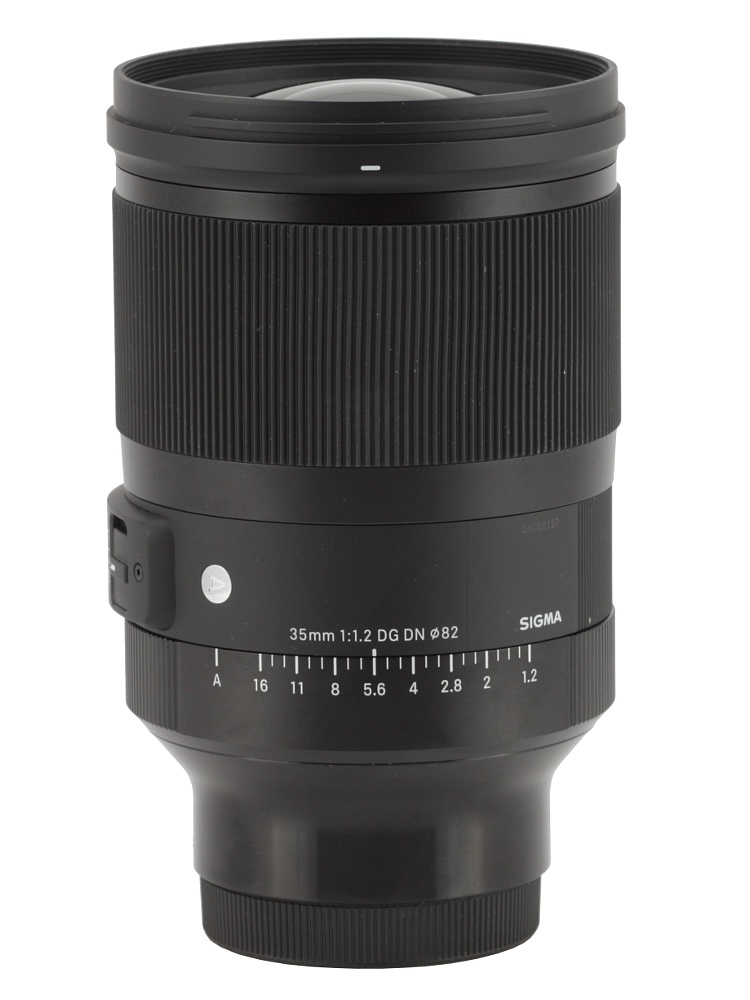
The build quality of the lens is good, and it has a very sturdy feel to it. The aperture is composed of a 9-blade diaphragm and interestingly, these blades are not rounded. The focus is an internal floating focus mechanism designed to give better optical performance at close distances. There are 13 elements in 11 groups in the lens, including SLD and FLD elements. A shiny "A" is emblazoned on the side of the lens. Half of this matte finished area is ridged, presumably for better handling. Instead the lens features a shiny black section of finishing near the lens mount, then a dull matte finish on the lens midsection. The 35mm features a new finishing texture, doing away with the rubberized finish that had a tendency to break down over time and use. It has designed three categories within its new "Global Vision" of lenses - Sports, Art and Contemporary, and a new look is part of the package. Sigma has moved in a new direction with its lens design. The lens isn't designed as a macro lens, but provides 0.19x magnification when used at its minimum close-focusing distance of just under 12 inches (30cm). The focus ring doesn't move during focusing, and autofocus results can be overridden at any time by simply turning the focus ring. While this system has historically produced fast and near-silent autofocus results, the implementation is a bit different on the 35mm, where it is slower than we'd expect, taking more than a second to focus between infinity and close-focus. The Sigma 35mm ƒ/1.4 uses Sigma's HSM (Hypersonic Motor) focusing technology. On the 1Ds mkIII, there's just slightly more distortion, with a maximum result of +0.25% The 35mm ƒ/1.4 DG HSM does fairly well to restrict distortion, showing a consistent +0.2% barrel distortion in the corners when mounted on the Canon 7D. At ƒ/4 and smaller apertures, falloff results are a quarter-stop or less, which isn't really significant.
#Sigma 35mm 1.2 full
On the full-frame 1Ds mkIII however, it's more significant: at ƒ/1.4 light falls off to make the extreme corners more than a full stop darker than the center at ƒ/2, this falloff lowers to around 2/3EV. At any other setting, light falloff is insignificant. This CA is evident in this lens, showing as magenta fringing on areas outside the plane of focus, but its not as prevalent as other fast glass we have tested.Ĭorner shading isn't really a problem on the sub-frame Canon 7D, with the only noteworthy results being extreme corners that are 1/3EV darker than the center, when set to ƒ/1.4. The Sigma 35mm ƒ/1.4 DG HSM provides a very good level of resistance to chromatic aberration, and it's fairly constant across the range of apertures (if you see it, you'll see it in the corners in areas of high contrast).Įven more noteworthy is a low amount of longitudinal chromatic aberration, which is typical of very fast lenses (ie., ƒ/1.4 or faster). Mounted on the subframe Canon 7D, performance for sharpness is very similar, perhaps a bit more forgiving at the ƒ/1.4 setting. This performance continues through to ƒ/8, and diffraction limiting begins to set in at ƒ/11, but you don't see the impact of this until ƒ/16, where a generalized softness begins to descend upon the image. Stopping down to just ƒ/2 everything gets a little sharper, but corner softness isn't really addressed you have to stop down to ƒ/2.8 for that, where the corners are tamed enough that the lens is offering practically tack-sharp performance from corner to corner. For isolating a subject this is actually quite good, but if you want corner to corner sharpness you will need to stop down significantly. Mounted on the full-frame Canon 1Ds mkIII, the lens produces images with a sharp center but significantly soft corners when used wide open at ƒ/1.4.

The Sigma 35mm ƒ/1.4 DG HSM produces surprisingly sharp results, even when used at its wider apertures, though it must be stopped down slightly for maximal sharpness. The Sigma 35mm ƒ/1.4 DG HSM takes 67mm filters, ships with a petal-shaped lens hood and is available now for around $900.


 0 kommentar(er)
0 kommentar(er)
